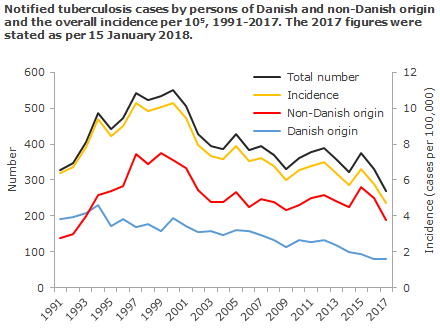Tuberculosis incidence decreased in 2016
The decrease was seen among Danes and immigrants alike, but nearly half of all tuberculosis cases had presumably become infected in Denmark.
2016 saw a total of 331 notified tuberculosis (TB) cases; 81 among persons of Danish origin and 250 among persons of non-Danish origin (immigrants or descendants to immigrants). The total incidence was 5.7 per 100,000; 1.6 per 100,000 among persons of Danish origin and 35.5 per 100,000 among persons of non-Danish origin.
The development in the number of notified TB cases in the 1991-2017 period, by persons of Danish and non-Danish origin, and the total incidence per 100,000 are shown in the figure.

As previously, the highest incidence (11.8 cases per 100,000) was seen in the City of Copenhagen, corresponding to 27% of all detected tuberculosis cases.
Furthermore, North Jutland recorded an incidence above the national mean (7.2 per 100,000), whereas the lowest incidence was seen in East Zealand (2.9 per 100,000).
Greenlanders in Denmark still form the largest single group, stated as number of cases, among TB cases of non-Danish origin, whereas the highest TB incidences are seen among people from Eritrea, Greenland, Somalia, the Philippines and Pakistan.
Although the number of tuberculosis cases declined once again in 2016 (and likely also will in 2017, see figure) after increasing in 2015, several conditions are threatening the WHO’s long-term objective of eliminating TB by 2050.
In countries that are in the TB pre-elimination phase, the ratio of child to adult TB cases is a marker for transmission as children will always have become infected recently. The number of TB cases in children seems to have stagnated, and it is worrying that nearly all children with TB born in Denmark are assessed to have become infected in Denmark.
The number of TB cases in persons of non-Danish origin has not been declining since the beginning of the 2000s. It is still important to ensure effective screening for active TB in fugitives, migrants and family-reunified people from areas with a high TB incidence. Additionally, screening should be considered particularly of younger individuals of non-Danish origin for so-called latent TB infection, as preventive treatment will, in many cases, serve to avoid that TB later becomes active.